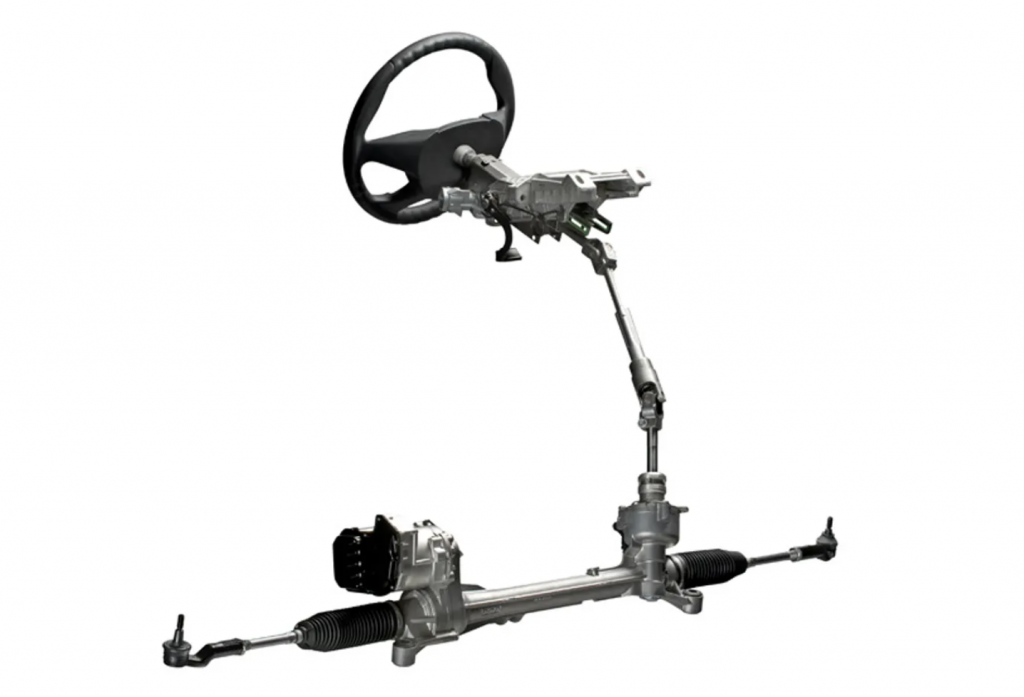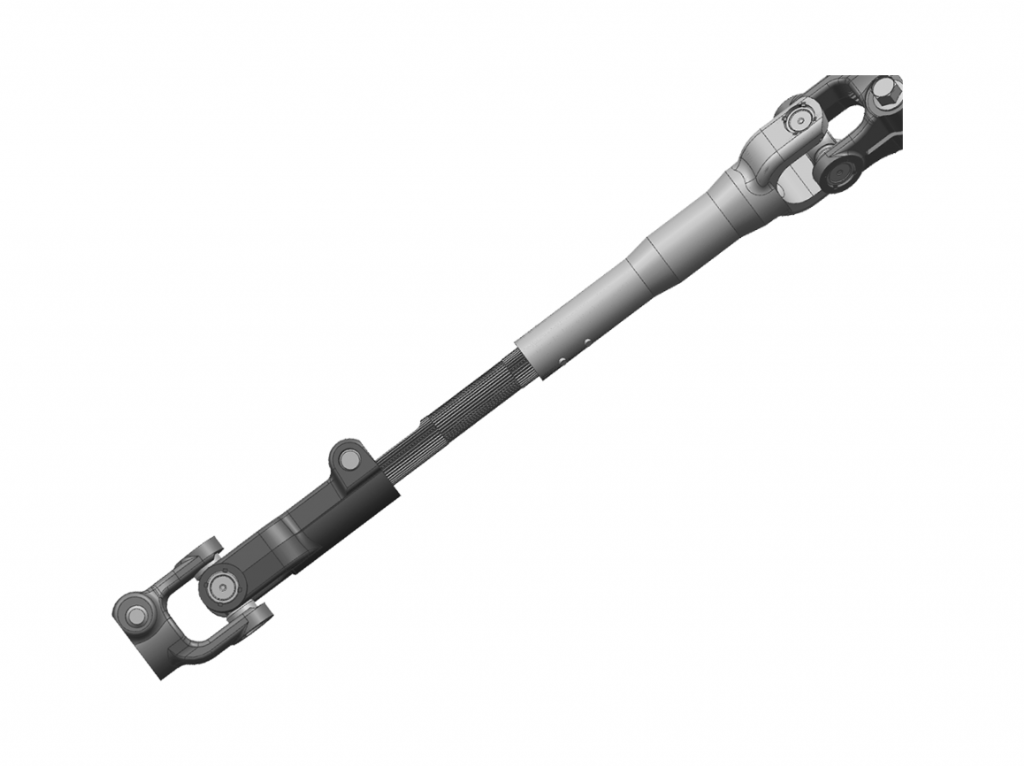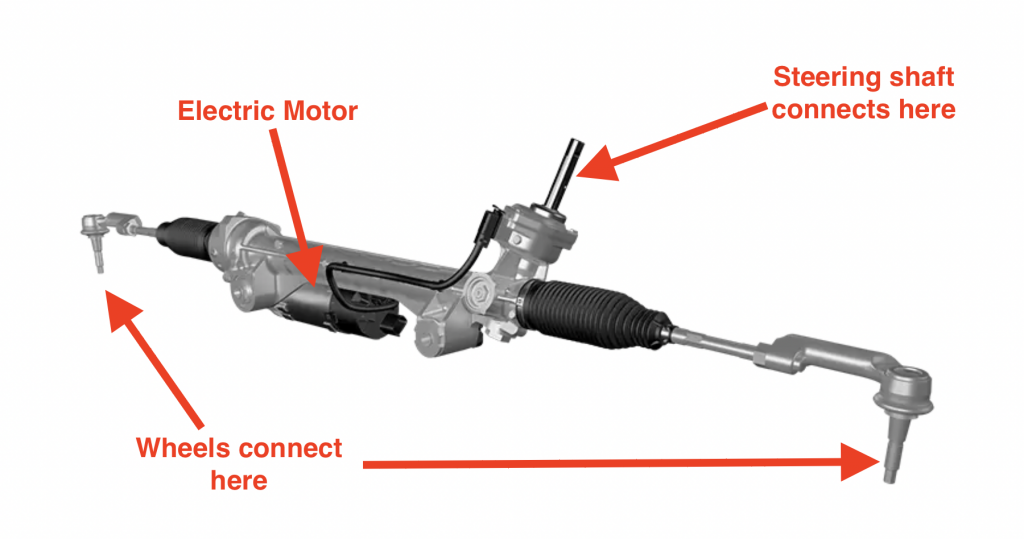Manufacturing experts at Munro & Associates are tearing into a Tesla Cybertruck right now and discovering some fascinating stuff. What’s especially cool is their recent teardown of the truck’s steering system, which is totally different than a conventional steering system in that the steering wheel is not mechanically connected to the front wheels. That may sound dangerous to you, but it turns out, Tesla has lots of redundancies built in. Here’s a look at some of them.
OK, first things first: We should look at how a typical automobile steering system works. When you turn the steering wheel, a torque sensor either near the steering wheel or built into the rack reads your steering input input and processes it through a controller, ultimately sending current to an electric motor in the steering rack. This electric motor then moves the rack left and right, which moves the tie rods in and out, pushing or pulling the steering knuckle, turning the car’s wheels. Thus, it’s the electric motor doing all the work; your hands are only giving an input telling that motor which direction it should spin and how much effort it should exert.
Still, there is a physical connection between the steering wheel and those wheels, so if the power steering stops working, you can still turn. Here’s what a typical electric power steering system looks like.
A Typical Steering Rack

Your steering wheel connects to a steering intermediate shaft, which is shown below. It has two universal joints in it to allow it to rotate even when you tilt the steering wheel up and down, and even when the car flexes a bit during driving. It’s also designed to collapse in the case of a crash:

That intermediate shaft connects to a steering rack, which looks like this:

As you can see, even if you for some reason lose power and the electric motor stops assisting you, you can still turn the wheel, which will send torque down the intermediate shaft, into the rack, and across those tie rods that are connected to the front steering knuckles that the wheels bolt to (via a wheel hub).
It’s worth noting that sometimes, in cases where packaging can be tricky, the electric motor is connected to the column/intermediate shaft itself, spinning it instead of directly acting on the rack. Nonetheless, this doesn’t change my main point, which is: On a typical steering system, there is a physical connection between the steering wheel and the front wheels.

Tesla’s Steer-By-Wire
The Tesla Cybertruck is different. It uses a so-called “steer by wire” system (Infiniti had a similar system, though there was a clutched mechanical backup; the Tesla has no such thing), which means that you replace that intermediate shaft shown above with… a wire. That’s it. There is no physical connection between the steering wheel and the wheels. If the system fails completely, turning your steering wheel will not result in the front wheels turning.
As you can imagine, a complete system failure simply can not happen, which is why Tesla and ZF (the steering supplier) have built in multiple failsafes, which Munro & Associates explores in this new video.
As shown and mentioned before: There is no intermediate shaft. At all. The steering wheel connects to a contraption that includes a tilt/telescoping steering wheel position-adjuster, an electric motor, and various sensors. Below is the entire steering “column.”
Steering ‘Feel’

The column features a force-feedback motor that takes input from the steering wheel sensor and steering rack and actually “”artificially” sends forces into the steering wheel so that the driver experiences an intuitive “feel” based on the driving situation:

Munro went for a ride with Chris Mantzios, ZF’s Vehicle Dynamics & Steering Feel Specialist. He described to Sandy and the team how that motor in the steering column works with the whole system to give the vehicle a natural steering feel.
“We wanted to show how natural the steering effort feels in the vehicle…We do have a steering input that we read from our sensor,” he says in the video above. “We send that signal right to the front wheel actuator, which is in position-control…it will ask the front wheels to turn so much. Because it’s in position-control, the motor has to overcome the load to basically get to that position…we look at the motor information and we convert all that intelligently into a rack force. Then that rack-force…we do put it through what we call an inverse boost curve that will give us a torque request to the hand wheel. And our torque controller on the hand-wheel generates that torque for you.”
Here is the sensor in the column that reads the driver’s input:

Tesla’s Ethernet Cables And 48-Volt System
Those steering inputs from that sensor get sent into these ethernet cables:

Notice how these cables are sending signals and motor power through small wires/connectors. They’re able to do this because of relatively low I^2R losses since the Cybertruck incorporates a 48-volt system instead of a 12-volt system. We know that Power is equal to current times voltage; so if you need a certain amount of power for an electric motor to turn front wheels, then if you quadruple the voltage, you can divide the current by four. Less current means fewer I^2 losses, which are generally what dictate wire thickness.


I have to say: The flat ethernet cables are fascinating; typical harnesses in cars are round, and feature relatively fat insulated wires. To see this flat thing with small connectors at each end — very interesting.
Redundancy Is Key To Steer-By-Wire’s Safety
Notice that there are two cables — that’s in order to provide redundancy to the steering wheel input signal, which gets sent to a module. That module isn’t shown in Munro’s video since it’s been analyzed by a client (probably an automaker or supplier looking to gain insight into Tesla’s work), but its job is to interpret the steering signal that the driver gives, and to then send an output signal to the motors on the steering rack:

Look at that rack. It looks totally different than a typical electric power steering rack, as not only is there no input shaft, but there are two motors driving the sliding rack. Those are there for redundancy in case one fails. Here’s a look from behind:

You can see that each motor has its own sensor to tell the module where the wheels are facing:

In addition, there’s a third sensor that acts as a so-called “tie breaker” in case there’s a discrepancy between the two motors’ sensors. “This is a triple-redundant system,” Munro says:

Update: It’s worth noting that, in the “how steer-by-wire” works video from Munro, a ZF rep response to a question about redundancy, saying: “There’s always a focus on dueling redundancy. There’s multiple aspects: You have to have abilities to have… dual power capability, there’s dual communication, there’s dual sensing technologies.” Based on that, it sounds like there have to be two isolated power sources, though I’ll want to dig into that further.
The Cybertruck’s Rear Steering Is Simpler
Out back, things are a little simpler, with the setup quite similar to typical rear-steer arrangements you might find in Porsches and Audis (though I’m fairly sure their systems don’t have ball joints, but rather just moves the rear “knuckles” in the bushings). There’s not much in the way of redundancy, but the good news is that if the rear-steer fails, it’s only steering a maximum of 10 degrees, and you’ve still got the fronts to keep the vehicle from going out of control.

Here’s how the Audi A8’s rear-steer works:
And just for fun, here’s GM’s Quadrasteer rear-steer system from 20 years ago:
How Do You Feel About Steer-By-Wire?
Are you cool with your steering wheel not being mechanically connected to the front wheels? Do you trust ZF’s/Tesla’s redundant system (great video above by ZF showing how it all works), or is there a bit of hesitancy on your side that it could all fail, and you’d be stuck unable to turn the vehicle?
To be, it seems like a cool system, and I see the advantages — specifically that you can change the steering ratio as a function of a number of inputs, such as vehicle speed (the Cybertruck turns farther for a given angular displacement of the steering wheel at slow speeds than it does at high speeds). And it does offer packaging advantages, though those redundant motors take up space, and add cost and weight. It’s interesting, but is it better overall? It’s hard to know.


Double-redundancy, triple redundancy, blah-blah-blah…That just seems like a lot of sensors and shit to go wrong.
I’m sure they work great when they’re new though…
I’m not an enormous fan of drive-by-wire generally, but there’s the platonic ideal of drive-by-wire, and then there’s drive-by-wire brought to you by Tesla, whose engineering quality and production standards need no introduction by now. This thing will have redundancy right up until the parts get a bit expensive or they start running behind on production or just decide they’re such smart brain geniuses that their racks don’t fail, and then it’ll go the way of the LiDAR sensors.
My basic take on the Cybertruck is that it’s effectively a social and increasingly likely physical suicide pact between you and Elon, and he ain’t in the car with you.
I was never really a fan of drive by wire either, though it has it’s pro’s and cons. considering the stories of Tesla Cars not seeing Motorcycles and even Munro’s reports on prior tesla quality, I would want to avoid one of these tanks near me on the road, but over time this is likely where many others will go as it does in theory reduce design constraints.
They’re really emphasizing the redundancy in the rack. What redundancy is there in the column? You know, the other half of the system sending the commands in the first place?
I don’t think the connector cable is an Ethernet cable. Ethernet cables are usually defined by the format of the data, the media, and the connectors. These formats are defined by the IEEE (Institute of Electrical and Electronics Engineers).
Possibly a vehicular cable such as CAN bus?
Early press coverage talked about the vehicle having gigabit Ethernet.
You’re certainly right that this cable would be out of place in a data center. I’m not up on IEEE standardization in the Automotive space so I can’t say if it’s truly ethernet in that sense or not, but I expect it’s using ethernet signaling or they wouldn’t call it that.
HDMI has 100 Mb ethernet built-in, as an example of some thing that I and presumably you aren’t used to seeing in datacomm.
https://standards.ieee.org/wp-content/uploads/import/documents/other/e2e-presentations/2019/S3-2_Dimitrakopolous-R-s.pdf
TIL about 1000Base-T1. Thank you!
“As you can imagine, a complete system failure simply can not happen”
I think it is meant in the same sense as “ you simply can not jump into an erupting volcano” or “you simply can not breathe fluorine gas”
It’s more like it’s a very bad thing that you should avoid if at all possible,
Losing electric power would cause a system failure. I can think of hundreds of ways that bad packets could would cause a system failure.
Calling this drive by wire makes it sound pretty benign, but it really it is drive by software. As a “software engineer” (I have a Cisco business card that says I am one, it means squat) I can say tha this is a dumb idea.
Fear not; Tesla has proved time and time again that they’d never half-ass their software, especially if it’s being deployed on public roads. We’re good.
I mean…
No, yeah, don’t worry, it’s gonna be fine.
A big part of Tesla’s motivation for developing steer-by-wire is for use in autonomous vehicles, which they are pouring billions of dollars into. It also gives them the freedom to put the steering wheel on either side, as well as vary the steering ratio and the amount of assist.
I’m into old cars. When I lived near a Pick-Your-Part I would spend the afternoon there just looking at stuff and taking things apart. When I look at a new car I imagine what its situation is going to be when it’s got 200K miles on it.
With that, my take is, no f’n way to this sh*t, and when ZF introduces full-on electric brakes I won’t be buying that either.
Airplanes need such tech when they weigh beyond what a guy pulling on cables can handle. Then you can add neato features like MCAS…
100% agree mcas certainly is a shit system only necessitated by Boeing desire to avoid completely redesigning the 737 like they should have bc the ‘necessary’ engine placement no longer worked with the fundamental aerodynamics and weight balance of the craft and their desire to avoid requiring retraining pilots on a new airframe.
MCAS has fuck all to do with the air transport equilivant, fly by wire which of course aircraft have been using safely for well over 40 years.
If this were the 1st implementation of steer by wire and/or if Tesla came up with this on their own (for the 1st time), there certainly would be more cause for concern.
How will this system will fair over 10-20 years is unknown. And as is (as far as I know) a steer by wire system without a mechanical backup, so sure new equals scary is a natural reaction. I certainly expect ZF and Tesla have put it through virtual and physical cycle testing just as any other automaker and tier 1 auto parts supplier.
I feel better about the system knowing that ZF had a hand in the engineering. I could see that getting rid of a mechanical connection could also pay dividends in potential crash safety in car designs overall.
Yeah, but software plays an important role in this, and I just don’t trust Tesla when it comes to software. The company has been more than happy to deploy pay-to-play beta testing in public streets for years. This could potentially fail due to software bugs. Doesn’t even need to be a bug witht he controller for this specific part of the hardware; it could simply be one that casues sudden power shutdown – and that is just one of many ways in which power can shutdown suddenly.
If I ever see one of these in the rearview mirror, I will go out of my way to make sure I’m overtaken as quickly as possible. The idea of driving in the vicinity of a Cybertruck is more terrifying to me than driving a Renault 4 between two semi-trucks, which I do quite often.
absolutely not
“Look at that rack.”
Giggity.
“As you can imagine, a complete system failure simply can not happen”
Yet it happened several time already
A complete system failure is different from one in which the system fails safely. Which I believe is what has been happening.
Ah yes, the old faithfull “system failed successfully”.
Yeah, it sounds weird but its a real thing. It’s impossible to design a system that is guaranteed never to fail. So you design so that if (when) it does, it fails in a safe manner. That usually means shutting everything down.
I think it’s an interesting test of concept and show that this does work. but I also kind of wonder why they did it. there are not really package concerns in a car with no engine in that space, and they seem to have put a lot of work into getting it to behave and feel like normal mechanical electrical steering, which wouldn’t be a problem if you didn’t do this. as noted earlier, it probably has something to do with tesla’s desire to try new things, which is cool for them I guess.
I think something like this would be kind of cool for a techno-futuristic hot rod (or even some weird custom restomod). you wouldn’t need a steering shaft messing with the looks, or trying to put a million universal links in it to get it where it needs to be.
It would also be useful for swapping a car between right- or left-hand-drive.
oh yeah, that would be a good use for it too. I guess that would be a good move for many automakers in both markets.
1st driver for this as the article/post points out is likely in prep for autonomous vehicles.
2nd reason I can see (again as the article mentions) is for infinitely variable steering ability, allowing when you’re driving to vary how much driver input is needed for a given steering angle at a given speed. Think about the inputs from a driver. Steering, acceleration and brake application. It’s a product didferentiator if you can make a +6000 lbs vehicle ‘feel’ like a sports car bc they can mimic the steering input of a sports car for a given desired steering angle at a given speed
This is nuts. The increased complexity over a powered mechanical system is massive and for what?
It’s pretty clear that the advantages are:
-more steering feel
-less turns of the wheel so you don’t have to go hand over hand, parking lots are less work
-packaging and manufacturing efficiency, much easier to plug in two wires then hook up a column
-easier to design for crash’s since you don’t have to consider a column
David’s untied shoe laces in the Instagram video are on brand.